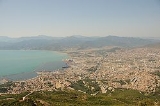
Béjaïa
Encyclopedia
Béjaïa, Vgaiet or Bejaya (Tifinagh
: ) is a Mediterranean port city on the Gulf of Béjaïa in Algeria
) is a Mediterranean port city on the Gulf of Béjaïa in Algeria
; it is the capital of Béjaïa Province
, Kabylia. Under French rule
, it was formerly known under various European names, such as Budschaja in German, Bugia in Italian, and Bougie buˈʒi (both of which are words for 'candle'). Béjaïa is the largest city in Kabylia
(second largest is Tizi Ouzou
), and one of the largest principally Berber speaking
cities.
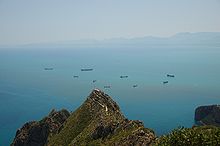 The town is overlooked by the mountain Yemma Gouraya, whose profile is said to resemble a sleeping woman; other nearby scenic spots include the Aiguades beach and the Pic des Singes (Monkey Peak); the latter site is a habitat
The town is overlooked by the mountain Yemma Gouraya, whose profile is said to resemble a sleeping woman; other nearby scenic spots include the Aiguades beach and the Pic des Singes (Monkey Peak); the latter site is a habitat
for the endangered Barbary Macaque
, Macaca sylvanus, which prehistorically had a much broader distribution than at present. All three of these geographic features are contained in the Gouraya National Park. The Soummam river runs past the town.
. A minor port in Carthaginian and Roman
times, Béjaïa was the Roman Saldae, a veteran colony founded by emperor Vespasian
of great importance in the province of Mauretania Caesariensis
, later in the fraction Sitifensis.
In the second or third century AD, Gaius Cornelius Peregrinus, a decurion (town councillor) from Saldae was a tribunus (military commander) of the auxiliary garrison at Alauna Carvetiorum
in northern Britain. An altar dedicated to him was discovered shortly before 1587 in the north-west corner of the fort, where it had probably been re-used in a late-Roman building (source).
It became the capital of the short-lived African kingdom of the Germanic Vandals
(founded in 429-430), which was wiped out circa 533 by the Byzantines who established the African prefecture and later the Exarchate of Carthage. It had disappeared but was refounded by the Berber
Hammadid
dynasty (whose capital it became) in the 11th century, and became an important port and cultural center. As a principal town of the Hammadid leader, Emir En Nasser, Béjaïa flourished and was renamed En Nassria. En Nasser's son, el Mansour, built an impressive palace inside the fortifications constructed by his father. The Hammadid Empire fell in 1152, when the Almohad
ruler, Abd al-Mu'min, invaded central Maghreb from Morocco
. The son of a Pisan merchant (and probably consul), posthumously known as Fibonacci
, there learned under the Almohad dynasty about Arabic numerals, and introduced them and modern mathematics into feudal Europe.
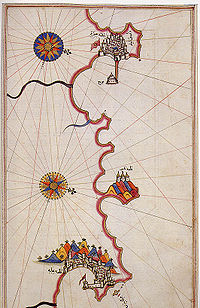 In the 13th century Béjaïa was acquired by the Hafsid Empire when the dynasty took control
In the 13th century Béjaïa was acquired by the Hafsid Empire when the dynasty took control
of Tunis
. Pirates were active along the Barbary Coast
starting in the 16th century.
After a Spanish
occupation (1510–55), the city was taken by the Ottoman Turks
in the Capture of Bougie
in 1555. Until it was captured by the French
in 1833, Béjaïa was a stronghold of the Barbary pirates (see Barbary States).
It was Christianized in the 5th century, became officially Arian
under the Vandals
, and then Muslim under the Berbers.
City landmarks include a 16th-century mosque and a casbah (fortress) built by the Spanish in 1545.
In the museum of Béjaïa can be seen a picture of Orientalist painter Maurice Boitel
, who painted in the city for a while.
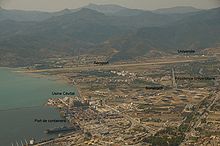 The northern terminus of the Hassi Messaoud
The northern terminus of the Hassi Messaoud
oil pipeline from the Sahara, Béjaïa is the principal oil
port of the Western Mediterranean. Exports, aside from crude petroleum, include iron
, phosphate
s, wine
s, dried fig
s, and plum
s. The city also has textile
and cork
industries.
Cevital
has its head office in the city.
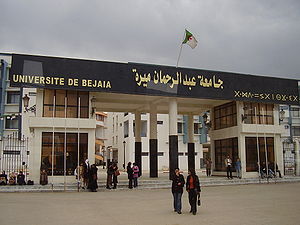 University of Béjaïa
University of Béjaïa
is located in the city.
 Béjaïa has an official friendly relationship (protocole d'amitié) with:
Béjaïa has an official friendly relationship (protocole d'amitié) with:
Brest, France
, since 1995
Tifinagh
Tifinagh is a series of abjad and alphabetic scripts used by some Berber peoples, notably the Tuareg, to write their language.A modern derivate of the traditional script, known as Neo-Tifinagh, was introduced in the 20th century...
:
 ) is a Mediterranean port city on the Gulf of Béjaïa in Algeria
) is a Mediterranean port city on the Gulf of Béjaïa in AlgeriaAlgeria
Algeria , officially the People's Democratic Republic of Algeria , also formally referred to as the Democratic and Popular Republic of Algeria, is a country in the Maghreb region of Northwest Africa with Algiers as its capital.In terms of land area, it is the largest country in Africa and the Arab...
; it is the capital of Béjaïa Province
Béjaïa Province
Béjaïa is a province of Algeria. The capital city is Béjaïa. Gouraya National Park is there. A population of the endangered primate, Barbary Macaque is found within this the province's Gouraya National Park; this canid has a severely restricted and disjunctive range.-Administrative divisions:The...
, Kabylia. Under French rule
French colonial empires
The French colonial empire was the set of territories outside Europe that were under French rule primarily from the 17th century to the late 1960s. In the 19th and 20th centuries, the colonial empire of France was the second-largest in the world behind the British Empire. The French colonial empire...
, it was formerly known under various European names, such as Budschaja in German, Bugia in Italian, and Bougie buˈʒi (both of which are words for 'candle'). Béjaïa is the largest city in Kabylia
Kabylie
Kabylie or Kabylia , is a region in the north of Algeria.It is part of the Tell Atlas and is located at the edge of the Mediterranean Sea. Kabylia covers several provinces of Algeria: the whole of Tizi Ouzou and Bejaia , most of Bouira and parts of the wilayas of Bordj Bou Arreridj, Jijel,...
(second largest is Tizi Ouzou
Tizi Ouzou
Tizi Ouzou is a city in Kabylia, Algeria, where it ranks second in population after Béjaïa. It is the capital and largest city of Tizi Ouzou Province and of Great Kabylia .-Etymology:The name comes from the Kabylian Berber Tizi n Uzezzu and is pronounced Tizuzzu, commonly...
), and one of the largest principally Berber speaking
Kabyle language
Kabyle or Kabylian is a Berber language spoken by the Kabyle people north and northeast of Algeria. Estimates about the number of speakers range from 5 million to about 7 million speakers worldwide, the majority in Algeria.-Classification:The classification of Kabyle is Afro-Asiatic, Berber and...
cities.
Geography

Habitat
* Habitat , a place where a species lives and grows*Human habitat, a place where humans live, work or play** Space habitat, a space station intended as a permanent settlement...
for the endangered Barbary Macaque
Barbary Macaque
The Barbary Macaque , or Common macaque, is a macaque with no tail. Found in the Atlas Mountains of Algeria and Morocco with a small population, of unknown origin, in Gibraltar, the Barbary Macaque is one of the best-known Old World monkey species. Besides humans, they are the only primates that...
, Macaca sylvanus, which prehistorically had a much broader distribution than at present. All three of these geographic features are contained in the Gouraya National Park. The Soummam river runs past the town.
History
Béjaïa was first inhabited by Numidian BerbersBerber people
Berbers are the indigenous peoples of North Africa west of the Nile Valley. They are continuously distributed from the Atlantic to the Siwa oasis, in Egypt, and from the Mediterranean to the Niger River. Historically they spoke the Berber language or varieties of it, which together form a branch...
. A minor port in Carthaginian and Roman
Roman Empire
The Roman Empire was the post-Republican period of the ancient Roman civilization, characterised by an autocratic form of government and large territorial holdings in Europe and around the Mediterranean....
times, Béjaïa was the Roman Saldae, a veteran colony founded by emperor Vespasian
Vespasian
Vespasian , was Roman Emperor from 69 AD to 79 AD. Vespasian was the founder of the Flavian dynasty, which ruled the Empire for a quarter century. Vespasian was descended from a family of equestrians, who rose into the senatorial rank under the Emperors of the Julio-Claudian dynasty...
of great importance in the province of Mauretania Caesariensis
Mauretania Caesariensis
Mauretania Caesariensis was a Roman province located in northwestern Africa. It was the easternmost of the North African Roman provinces, mainly in present Algeria, with its capital at Caesarea , now Cherchell.-Historical background:In the first century AD, Roman...
, later in the fraction Sitifensis.
In the second or third century AD, Gaius Cornelius Peregrinus, a decurion (town councillor) from Saldae was a tribunus (military commander) of the auxiliary garrison at Alauna Carvetiorum
Alauna (Maryport)
Alauna , was a fort in the Roman province of Britannia...
in northern Britain. An altar dedicated to him was discovered shortly before 1587 in the north-west corner of the fort, where it had probably been re-used in a late-Roman building (source).
It became the capital of the short-lived African kingdom of the Germanic Vandals
Vandals
The Vandals were an East Germanic tribe that entered the late Roman Empire during the 5th century. The Vandals under king Genseric entered Africa in 429 and by 439 established a kingdom which included the Roman Africa province, besides the islands of Sicily, Corsica, Sardinia and the Balearics....
(founded in 429-430), which was wiped out circa 533 by the Byzantines who established the African prefecture and later the Exarchate of Carthage. It had disappeared but was refounded by the Berber
Berber people
Berbers are the indigenous peoples of North Africa west of the Nile Valley. They are continuously distributed from the Atlantic to the Siwa oasis, in Egypt, and from the Mediterranean to the Niger River. Historically they spoke the Berber language or varieties of it, which together form a branch...
Hammadid
Hammadid
The Hammadids were a Berber dynasty who ruled an area roughly corresponding to north-eastern modern Algeria for about a century and a half , until they were destroyed by the Almohads...
dynasty (whose capital it became) in the 11th century, and became an important port and cultural center. As a principal town of the Hammadid leader, Emir En Nasser, Béjaïa flourished and was renamed En Nassria. En Nasser's son, el Mansour, built an impressive palace inside the fortifications constructed by his father. The Hammadid Empire fell in 1152, when the Almohad
Almohad
The Almohad Dynasty , was a Moroccan Berber-Muslim dynasty founded in the 12th century that established a Berber state in Tinmel in the Atlas Mountains in roughly 1120.The movement was started by Ibn Tumart in the Masmuda tribe, followed by Abd al-Mu'min al-Gumi between 1130 and his...
ruler, Abd al-Mu'min, invaded central Maghreb from Morocco
Morocco
Morocco , officially the Kingdom of Morocco , is a country located in North Africa. It has a population of more than 32 million and an area of 710,850 km², and also primarily administers the disputed region of the Western Sahara...
. The son of a Pisan merchant (and probably consul), posthumously known as Fibonacci
Fibonacci
Leonardo Pisano Bigollo also known as Leonardo of Pisa, Leonardo Pisano, Leonardo Bonacci, Leonardo Fibonacci, or, most commonly, simply Fibonacci, was an Italian mathematician, considered by some "the most talented western mathematician of the Middle Ages."Fibonacci is best known to the modern...
, there learned under the Almohad dynasty about Arabic numerals, and introduced them and modern mathematics into feudal Europe.

of Tunis
Tunis
Tunis is the capital of both the Tunisian Republic and the Tunis Governorate. It is Tunisia's largest city, with a population of 728,453 as of 2004; the greater metropolitan area holds some 2,412,500 inhabitants....
. Pirates were active along the Barbary Coast
Barbary Coast
The Barbary Coast, or Barbary, was the term used by Europeans from the 16th until the 19th century to refer to much of the collective land of the Berber people. Today, the terms Maghreb and "Tamazgha" correspond roughly to "Barbary"...
starting in the 16th century.
After a Spanish
Spain
Spain , officially the Kingdom of Spain languages]] under the European Charter for Regional or Minority Languages. In each of these, Spain's official name is as follows:;;;;;;), is a country and member state of the European Union located in southwestern Europe on the Iberian Peninsula...
occupation (1510–55), the city was taken by the Ottoman Turks
Ottoman Empire
The Ottoman EmpireIt was usually referred to as the "Ottoman Empire", the "Turkish Empire", the "Ottoman Caliphate" or more commonly "Turkey" by its contemporaries...
in the Capture of Bougie
Capture of Bougie
The Capture of Bougie occurred in 1555 when the Ottoman ruler of Algiers Salah Rais took the city of Bougie from the Spaniards. The Spanish presidio was the main fortification in Bougie, occupied by about 100 men under Luis Peralta, and then his son Alonso Peralta...
in 1555. Until it was captured by the French
France
The French Republic , The French Republic , The French Republic , (commonly known as France , is a unitary semi-presidential republic in Western Europe with several overseas territories and islands located on other continents and in the Indian, Pacific, and Atlantic oceans. Metropolitan France...
in 1833, Béjaïa was a stronghold of the Barbary pirates (see Barbary States).
It was Christianized in the 5th century, became officially Arian
Arianism
Arianism is the theological teaching attributed to Arius , a Christian presbyter from Alexandria, Egypt, concerning the relationship of the entities of the Trinity and the precise nature of the Son of God as being a subordinate entity to God the Father...
under the Vandals
Vandals
The Vandals were an East Germanic tribe that entered the late Roman Empire during the 5th century. The Vandals under king Genseric entered Africa in 429 and by 439 established a kingdom which included the Roman Africa province, besides the islands of Sicily, Corsica, Sardinia and the Balearics....
, and then Muslim under the Berbers.
City landmarks include a 16th-century mosque and a casbah (fortress) built by the Spanish in 1545.
In the museum of Béjaïa can be seen a picture of Orientalist painter Maurice Boitel
Maurice Boitel
Maurice Boitel Maurice Boitel Maurice Boitel (July 31, 1919 – August 11, 2007 in Audresselles (Pas-de-Calais), was a French painter.-Artistic life:Maurice Boitel belonged to the art movement called "La Jeune Peinture" ("Young Picture") of the School of Paris, with painters like Bernard Buffet, Yves...
, who painted in the city for a while.
Demography
The population of the city in 2005 was 187,076, while the population of the whole wilaya (province) was 905,000.| Year | Population | Year | Population |
|---|---|---|---|
| 1901 | 14,600 | 1954 | 43,900 |
| 1906 | 17,500 | 1960 | 63,000 |
| 1911 | 10,000 | 1966 | 49,900 |
| 1921 | 19,400 | 1974 | 104,000 |
| 1926 | 15,900 | 1977 | 74,000 (town) 89,500 (municipality) |
| 1931 | 25,300 | 1987 | 114,500 |
| 1936 | 30,700 | 1998 | 144,400 |
| 1948 | 28,500 |
Economy

Hassi Messaoud
Hassi Messaoud is a town in Ouargla province, southeast Algeria, north Africa. Oil was discovered there in 1956 and the town's prominence has grown rapidly since then. It is an oil refinery town named after the first oil well. A water well, dug in 1917, can be found on the airport side of town...
oil pipeline from the Sahara, Béjaïa is the principal oil
Oil
An oil is any substance that is liquid at ambient temperatures and does not mix with water but may mix with other oils and organic solvents. This general definition includes vegetable oils, volatile essential oils, petrochemical oils, and synthetic oils....
port of the Western Mediterranean. Exports, aside from crude petroleum, include iron
Iron
Iron is a chemical element with the symbol Fe and atomic number 26. It is a metal in the first transition series. It is the most common element forming the planet Earth as a whole, forming much of Earth's outer and inner core. It is the fourth most common element in the Earth's crust...
, phosphate
Phosphate
A phosphate, an inorganic chemical, is a salt of phosphoric acid. In organic chemistry, a phosphate, or organophosphate, is an ester of phosphoric acid. Organic phosphates are important in biochemistry and biogeochemistry or ecology. Inorganic phosphates are mined to obtain phosphorus for use in...
s, wine
Wine
Wine is an alcoholic beverage, made of fermented fruit juice, usually from grapes. The natural chemical balance of grapes lets them ferment without the addition of sugars, acids, enzymes, or other nutrients. Grape wine is produced by fermenting crushed grapes using various types of yeast. Yeast...
s, dried fig
Ficus
Ficus is a genus of about 850 species of woody trees, shrubs, vines, epiphytes, and hemiepiphyte in the family Moraceae. Collectively known as fig trees or figs, they are native throughout the tropics with a few species extending into the semi-warm temperate zone. The Common Fig Ficus is a genus of...
s, and plum
Plum
A plum or gage is a stone fruit tree in the genus Prunus, subgenus Prunus. The subgenus is distinguished from other subgenera in the shoots having a terminal bud and solitary side buds , the flowers in groups of one to five together on short stems, and the fruit having a groove running down one...
s. The city also has textile
Textile
A textile or cloth is a flexible woven material consisting of a network of natural or artificial fibres often referred to as thread or yarn. Yarn is produced by spinning raw fibres of wool, flax, cotton, or other material to produce long strands...
and cork
Cork (material)
Cork is an impermeable, buoyant material, a prime-subset of bark tissue that is harvested for commercial use primarily from Quercus suber , which is endemic to southwest Europe and northwest Africa...
industries.
Cevital
Cevital
Cevital spa is a major Algerian manufacturer of food products, created by Issad Rebrab. The company specializes in food industry. The company's headquarters are in Béjaïa.Cevital is a founding member of the Desertec project....
has its head office in the city.
Education

University of Béjaïa
The University of Béjaïa is a university in Béjaïa, Algeria. It is named after Abderrahmane Mira.-External links:*...
is located in the city.
Friendly relationship

Brest, France
Brest, France
Brest is a city in the Finistère department in Brittany in northwestern France. Located in a sheltered position not far from the western tip of the Breton peninsula, and the western extremity of metropolitan France, Brest is an important harbour and the second French military port after Toulon...
, since 1995

